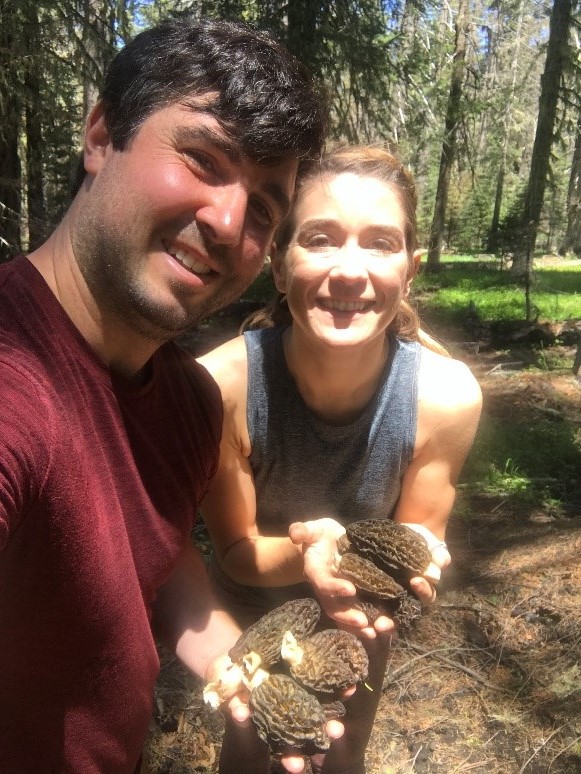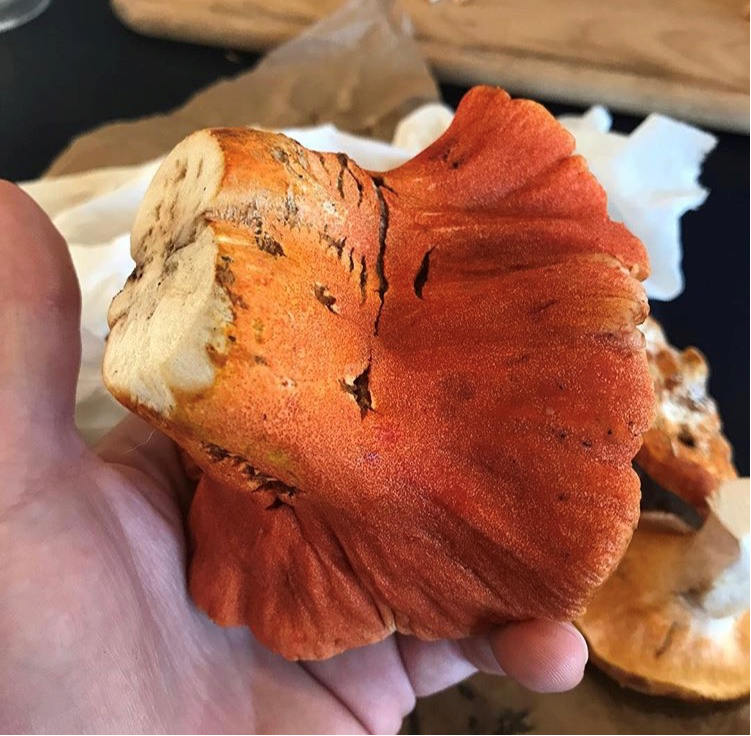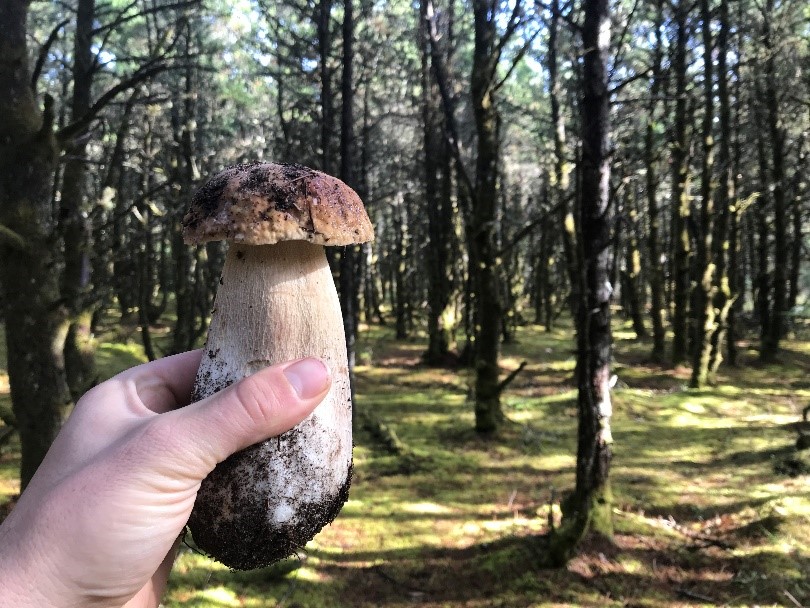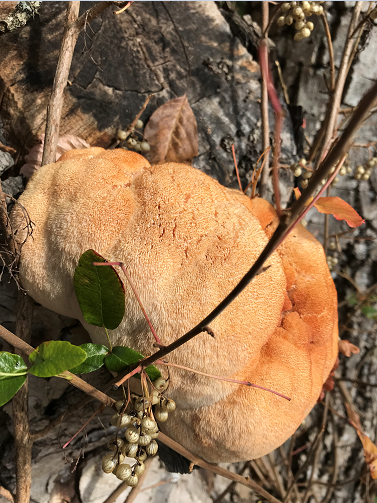
Here in the Pacific Northwest we have a large variety of choice wild edible mushrooms. Many of these mushrooms cannot be cultivated, making them rare delicacies that are only found if the soil, weather, elevation, trees, temperature, etc. are just right. After the rains fall, I head to the forests in search of delicious and nutritious edible fungi.
Mushroom hunting is a hobby shared by many, but what some foragers may not know is they are a great source of nutrients and vitamins. Here are some of my favorite mushrooms to hunt for and the unique benefits of each.
*Warning* - Wild mushrooms need to be properly identified before consumption. It is best to consult a professional to confirm finds are not poisonous, and “when in doubt, throw it out”.
Morels (Morchella sp.)
 Summer fires have become more common in the Pacific Northwest, but with them come morels in spring. Morels are typically associated with pine trees growing at elevations >3000 ft where snow is abundant during the winter. The combination of nutrients from a wildfire mixed with the moisture from rapidly melting snow results in a phenomenon that has people flocking to charred landscapes in April/May. This mysterious mushroom has one of the highest vitamin D contents of any wild mushroom, at 206 IU/100 g fresh weight [1]. Morel mushrooms contain powerful antioxidants which prevent cellular damage caused by reactive oxygen species (ROS); but more research is needed to identify the specific compounds responsible [2]. Amino acids (glutamic acid, alanine), fatty acids (linoleic, oleic, palmitic), and organic acids (oxalic, quinic, malic, citric) are also present at high levels [3].
Summer fires have become more common in the Pacific Northwest, but with them come morels in spring. Morels are typically associated with pine trees growing at elevations >3000 ft where snow is abundant during the winter. The combination of nutrients from a wildfire mixed with the moisture from rapidly melting snow results in a phenomenon that has people flocking to charred landscapes in April/May. This mysterious mushroom has one of the highest vitamin D contents of any wild mushroom, at 206 IU/100 g fresh weight [1]. Morel mushrooms contain powerful antioxidants which prevent cellular damage caused by reactive oxygen species (ROS); but more research is needed to identify the specific compounds responsible [2]. Amino acids (glutamic acid, alanine), fatty acids (linoleic, oleic, palmitic), and organic acids (oxalic, quinic, malic, citric) are also present at high levels [3].
Golden Chanterelle (Cantharellus formosus)
 Chanterelles are the state mushroom of Oregon. They are easy to identify, are plentiful in dark and damp old growth forests, and are packed full of nutrients. When heavy rains begin in the fall, expect to see the gold color popping up from beneath forest litter. Chanterelles are high in potassium and B-vitamins, and like morels, have one of the highest natural concentrations of vitamin D [4,5]. The golden chanterelle grows slowly for over a month, so it needs a natural insecticide to prevent its destruction before releasing spores. It is believed that by having high levels of vitamin D, only 1% of chanterelles are damaged by insects while other mushrooms containing only trace levels of vitamin D are 40-80% insect invaded [6].
Chanterelles are the state mushroom of Oregon. They are easy to identify, are plentiful in dark and damp old growth forests, and are packed full of nutrients. When heavy rains begin in the fall, expect to see the gold color popping up from beneath forest litter. Chanterelles are high in potassium and B-vitamins, and like morels, have one of the highest natural concentrations of vitamin D [4,5]. The golden chanterelle grows slowly for over a month, so it needs a natural insecticide to prevent its destruction before releasing spores. It is believed that by having high levels of vitamin D, only 1% of chanterelles are damaged by insects while other mushrooms containing only trace levels of vitamin D are 40-80% insect invaded [6].
Lobster Mushroom (Hypomyces lactifluorum)
 Lobster mushrooms are bizarre. They are a parasitic fungus that attacks a mushroom (typically Russula or Lactarius), completely changing the color, smell, interior, exterior, and potential toxic properties. A lobster mushroom has the color of a lobster and a mild seafood smell/flavor. For this reason, they are used as a seafood substitute/addition in soups and other dishes. I typically find them when looking for chanterelles. They are an excellent source of vitamin D and their nutrition seems to vary depending on the host mushroom. It is rumored that people sensitive to iodine and shellfish can react to lobster mushrooms, indicating that high levels of iodine or a protein common in seafood may be present (at least it smells like it!)
Lobster mushrooms are bizarre. They are a parasitic fungus that attacks a mushroom (typically Russula or Lactarius), completely changing the color, smell, interior, exterior, and potential toxic properties. A lobster mushroom has the color of a lobster and a mild seafood smell/flavor. For this reason, they are used as a seafood substitute/addition in soups and other dishes. I typically find them when looking for chanterelles. They are an excellent source of vitamin D and their nutrition seems to vary depending on the host mushroom. It is rumored that people sensitive to iodine and shellfish can react to lobster mushrooms, indicating that high levels of iodine or a protein common in seafood may be present (at least it smells like it!)
Porcini/King Bolete (Boletus edulis)
 The porcini mushroom can be found in many different environments, from sandy soils near the beach to dense dark forests high in the mountains. I commonly find them in the springtime when looking for morels or during summer months while hiking through coastal shore pines. They are prized for their flavor and aroma. Porcini have a very high level of selenium compared to other popular edible mushrooms [7]. They are also high in fiber, proteins, amino acids, antioxidants (ergothioneine and glutathione), and the elements potassium, calcium, magnesium and zinc [8,9].
The porcini mushroom can be found in many different environments, from sandy soils near the beach to dense dark forests high in the mountains. I commonly find them in the springtime when looking for morels or during summer months while hiking through coastal shore pines. They are prized for their flavor and aroma. Porcini have a very high level of selenium compared to other popular edible mushrooms [7]. They are also high in fiber, proteins, amino acids, antioxidants (ergothioneine and glutathione), and the elements potassium, calcium, magnesium and zinc [8,9].
Oregon White Truffle (Tuber oregonense)
 One of the rarest wild mushrooms is the Oregon white truffle. It is commonly associated with medium growth fir trees and hides under a layer of duff, making it very difficult to find without the help of hungry squirrels or truffle dogs. Truffles are prized for their potent aroma used to enhance dishes, and they are believed to be an aphrodisiac. Truffles provide nutrients to the tree and the tree provides sugar in return though a complex mycorrhizae network. Truffles are high in fat, protein, essential amino acids, and the essential elements iron, copper, zinc and manganese [10].
One of the rarest wild mushrooms is the Oregon white truffle. It is commonly associated with medium growth fir trees and hides under a layer of duff, making it very difficult to find without the help of hungry squirrels or truffle dogs. Truffles are prized for their potent aroma used to enhance dishes, and they are believed to be an aphrodisiac. Truffles provide nutrients to the tree and the tree provides sugar in return though a complex mycorrhizae network. Truffles are high in fat, protein, essential amino acids, and the essential elements iron, copper, zinc and manganese [10].
Lion’s Mane (Hericium erinaceus)
 Lion’s mane is an unmistakable mushroom. It is often large, white, and looks like a lion’s mane. I have only found a couple of them in nature, but the size itself provides plenty to eat. It is found on decaying hardwood like oak, birch and walnut in the spring and fall. Lion’s mane is well known for its health benefits, specifically relating to the nervous system and brain. It is commonly added as a powdered ingredient to brain-boosting and superfood products. As one study outlines, lion’s mane health properties include “antibiotic, anticarcinogenic, antidiabetic, antifatigue, antihypertensive, antihyperlipidemic, antisenescence, cardioprotective, hepatoprotective, nephroprotective, and neuroprotective properties and improvement of anxiety, cognitive function, and depression.” [11] Lion’s mane contains hericenones and erinacines, compounds which stimulate nerve growth factor (NGF), a neuropeptide that helps maintain and organize neurons [12]. Some animal studies have shown an increase in BDNF after consuming lion’s mane mushrooms, but more research is needed [13,14].
Lion’s mane is an unmistakable mushroom. It is often large, white, and looks like a lion’s mane. I have only found a couple of them in nature, but the size itself provides plenty to eat. It is found on decaying hardwood like oak, birch and walnut in the spring and fall. Lion’s mane is well known for its health benefits, specifically relating to the nervous system and brain. It is commonly added as a powdered ingredient to brain-boosting and superfood products. As one study outlines, lion’s mane health properties include “antibiotic, anticarcinogenic, antidiabetic, antifatigue, antihypertensive, antihyperlipidemic, antisenescence, cardioprotective, hepatoprotective, nephroprotective, and neuroprotective properties and improvement of anxiety, cognitive function, and depression.” [11] Lion’s mane contains hericenones and erinacines, compounds which stimulate nerve growth factor (NGF), a neuropeptide that helps maintain and organize neurons [12]. Some animal studies have shown an increase in BDNF after consuming lion’s mane mushrooms, but more research is needed [13,14].
The Dark Side of Mushrooms…
While mushrooms are high in nutrients, they are also known for absorbing chemicals (fertilizers, pesticides, herbicides) and heavy metals (lead, arsenic, cadmium, aluminum, and mercury). As a rule of thumb, I never pick mushrooms along trails or roads, clear-cuts, golf courses, within the city boundaries, or any other place exposed to chemicals or pollution. It’s better to be safe than sorry. If you commonly consume mushrooms (wild or cultivated) or products containing mushrooms (powders, pills, cosmetics), it is a good idea to test yourself for heavy metals and essential elements.
Foraging for wild mushrooms is as challenging as it is rewarding. Luckily in the Pacific Northwest we have opportunities year-round to search for choice edible fungus. It is pretty neat that mushrooms are the only natural source of vitamin D in the produce aisle, but you may be paying a pretty penny at the grocery store for morels, chanterelles, lobsters, and king boletes unless you get out in the forest and find some … just don’t tell anyone your spot!
Related Resources
- Blog: Heavy Metals in the Garden: Are Your Home-Grown Fruits and Vegetables Safe for Consumption?
- Blog: Where Does Dietary Iodine Come From?
- Blog: Brazil Nuts as a Selenium Supplement?
References
[1] Phillips KM, et al. Vitamin D and sterol composition of 10 types of mushrooms from retail suppliers in the United States. J Agric Food Chem. 2011;59(14):7841-53.
[2] Nitha B, et al. Evaluation of free radical scavenging activity of morel mushroom, Morchella esculenta mycelia: a potential source of therapeutically useful antioxidants. Pharm Biol. 2010;48(4):453-60.
[3] Tietel Z, Masaphy S. True morels (Morchella)-nutritional and phytochemical composition, health benefits and flavor: A review. Crit Rev Food Sci Nutr. 2018;58(11):1888-1901.
[4] Watanabe F, et al. Characterization of vitamin B₁₂compounds in the wild edible mushrooms black trumpet (Craterellus cornucopioides) and golden chanterelle (Cantharellus cibarius). J Nutr Sci Vitaminol (Tokyo). 2012;58(6):438-41.
[5] Cardwell G, et al. A review of mushrooms as a potential source of dietary vitamin D. Nutrients. 2018;10(10).
[6] https://www.madaboutmushrooms.com/mad_about_mushrooms/2015/01/chanterelles-101-post-script.html
[7] Falandysz J. Selenium in edible mushrooms. J Environ Sci Health C Environ Carcinog Ecotoxicol Rev. 2008;26(3):256-99.
[8] Falandysz J, et al. Multivariate characterization of elements accumulated in King Bolete Boletus edulis mushroom at lowland and high mountain regions. J Environ Sci Health A Tox Hazard Subst Environ Eng. 2008;43(14):1692-9.
[9] Kalaras MD, et al. Mushrooms: A rich source of the antioxidants ergothioneine and glutathione. Food Chem. 2017;233:429-433.
[10] Patel S, et al. Potential health benefits of natural products derived from truffles: A review. Trends in Food Science & Technology. 2017;70:1–8.
[11] Friedman M. Chemistry, Nutrition, and Health-Promoting Properties of Hericium erinaceus (Lion's Mane) Mushroom Fruiting Bodies and Mycelia and Their Bioactive Compounds. J Agric Food Chem. 2015;63(32):7108-23.
[12] Lai PL, et al. Neurotrophic properties of the Lion's mane medicinal mushroom, Hericium erinaceus (Higher Basidiomycetes) from Malaysia. Int J Med Mushrooms. 2013;15(6):539-54.
[13] Chiu CH, et al. Erinacine A-Enriched Hericium erinaceus Mycelium Produces Antidepressant-Like Effects through Modulating BDNF/PI3K/Akt/GSK-3β Signaling in Mice. Int J Mol Sci. 2018;19(2). pii: E341.
[14] Park YS, et al. Effect of an exo-polysaccharide from the culture broth of Hericium erinaceus on enhancement of growth and differentiation of rat adrenal nerve cells. Cytotechnology. 2002;39(3):155-62.
